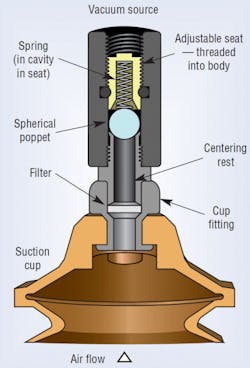Ideally, the suction cups in a vacuum-lifting system will contact a smooth, clean, flat work-piece surface squarely and make a complete seal. In the real world, the work piece surface may be porous, uneven, dirty — or even missing; a cup’s skirt may be worn or damaged; or a cup may overhang the edge of a work piece or be oriented over a hole in the material. Any of these conditions can draw enough ambient air into the system to prevent pulling sufficient vacuum to operate properly.
To deal with these problems in multiple-cup systems, EDCO USA, Fenton, Mo., offers Flow Sensor Valves (FSVs). These normally open valves snap closed when the flow through them exceeds a preset rate — thus isolating a problem cup. FSVs will automatically reset when the vacuum is turned off briefly. They are especially useful where work piece size and orientation vary. To maximize effectiveness, each suction cup in a multiple-cup system should be fitted with its own FSV.
The valves are insensitive to acceleration forces and may be installed in any physical orientation. They may be combined in a manifold or located in-line rather than right at the suction cup. Wherever installed, a suitable filter must be used upstream of the FSV. The system’s vacuum level has no effect on the FSV setpoint, but piping integrity is important because the valve will respond to a leaking fitting as readily as it will to leakage at a suction cup.
Another caveat: the system’s vacuum pump must have enough capacity to close all FSVs when cups are not sealed against a work piece plus the total flow through sealed cups due to porosity.
By using a flow meter, FSVs can be tuned to close at a particular flow rate. This is done by adjusting the distance from the FSV’s poppet to the seat, which also changes the bias-spring force that holds the poppet against the rest. (The seat can be repositioned with a screwdriver.) The valve should be set so that normal vacuum flow — when the cup is sealed against a work piece — is less than the setpoint flow. The valve then will remain open during normal operation and close only when flow becomes excessive.
The optimum flow rate setpoint is best determined by testing the porosity of sample work pieces with a flow meter — using the same suction cup size and style as will be used in the actual application. Porosity of items, such as corrugated board, can vary greatly from lot to lot so it is important to find the most porous part that the system is likely to handle. A safety factor should be added to the highest porosity-test value to allow for variations in work piece material, system vacuum level, increased leakage due to wear over time, and other factors. For porous work pieces, such as paper and corrugated cases, the safety factor probably should be in the 50% range. For non-porous work pieces, such as plastic or metal, a reduced factor may be used.
Contact EDCO USA by phone at (636) 349-2632, or visit www.edcousa.net.
About the Author
Richard Schneider
Contributing Editor
Contributing Editor, has been affiliated with Hydraulics & Pneumatics for more than 30 years and served as chief editor from 1987 through 2000. He received a BSME from Cornell University and also completed additional courses at the Milwaukee School of Engineering. His diverse background in industry includes ten years with a fluid power distributor and a variety of other professional positions. He has also been active with the National Fluid Power Association and Fluid Power Society.

Leaders relevant to this article:

